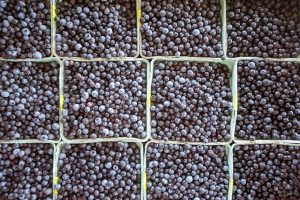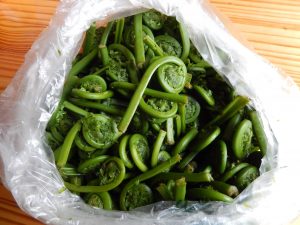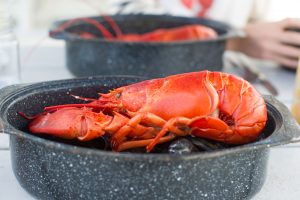Preserving (Maine) Foods FAQ
Table of Contents:
- How do I make Maine wild blueberry jam?
- How can I store fiddleheads for future use?
- What is the best way to store my leftover lobsters?
- Live Lobster
- Cooked Lobster
- Lobster Meat
- Freezing Lobster
- How do I use and preserve Maine cranberries?

How do I make Maine wild blueberry jam?
- Pick over fruit, removing any stems and leaves. Crush berries and measure 4½ cups of crushed Maine wild blueberries.
- Put into a large heavy pot. Add 2 tablespoons lemon juice and 7 cups granulated sugar; mix well. Place over high heat, stirring constantly, and bring to a full rolling boil. Immediately stir in 2 pouches of liquid pectin. Bring to a full rolling boil, and boil hard for 1 minute, stirring constantly.
- Remove from heat; quickly skim off foam, stir and skim off foam again. Carefully ladle into hot, sterilized jars, leaving 1/4-inch headspace. Adjust lids and process for 10 minutes in a boiling water bath.
Makes 5-6 pints.
Adapted from University of Maine Cooperative Extension’s Jellies, Jams, Spreads, Let’s Preserve Series, Bulletin #4039. Instructions for safe canning of jellies and jams, including recipes for grape-plum jelly, blueberry-spice jam, pear-apple jam, strawberry-rhubarb jelly, grape jelly, apple jelly, and peach-pineapple spread. Available online for purchase or free download.
How can I store fiddleheads for future use?
To freeze fiddleheads, prepare them as you would for the table. Blanch a small amount at a time for two minutes. Cool and drain. Pack into moisture- and vapor-proof containers and store them in the freezer.
For cooking instructions, see Facts on Fiddleheads, Bulletin #4198.
To pickle fiddleheads, pour enough cider vinegar (5% acidity) over the fiddleheads to cover; then strain it off into a pan. Add 1 cup of sugar for every gallon of vinegar. Add a 1/8 teaspoon each of pepper, ground nutmeg, cinnamon, allspice, and celery seed. Boil this syrup for 7-8 minutes, immediately pour the hot liquid over the fiddleheads that are packed into clean pint jars. Remove air bubbles, adjust the liquid to 1/2-inch headspace and wipe the jar rim. Apply two-piece dome lids and adjust lids to fingertip tight. Process for 15 minutes in a boiling water bath canner, ensuring a rolling boil for the full 15 minutes and at least 1-inch of water is covering all jars in the water bath.
Source: University of Maine Cooperative Extension’s Facts on Fiddleheads, Bulletin #4198. Fiddleheads, the young coiled leaves of the ostrich fern, are a Maine delicacy. This 4-page fact sheet has information on cooking and pickling fiddleheads, with 8 recipes. Available online for purchase or free download.
What is the best way to store my leftover lobsters?
Live Lobster
Live lobsters should be stored in open containers in your refrigerator, provided they are kept moist with seaweed, or seawater dampened towels or newspaper. Do NOT immerse lobsters in water or place on ice in an airtight container as they will suffocate and die. Live lobsters can live up to 48 hours after you’ve purchased them provided they are kept cold and their gills are kept moist, as described above.
Cooked Lobster
Store cooked lobsters in rigid, airtight containers. The product is best if used within three days from the time of cooking.
Lobster Meat
Lobster meat that has been immediately removed from the shell after cooking can be stored in an airtight container for up to four days.
Freezing Lobster
For best quality, lobster should be frozen uncooked. Freeze the lobster whole, or clean it and freeze just shell portions that contain the edible meat. (Some lobsters have large front claws that contain edible meat, while others have edible meat mainly in the tail section.)
Freeze lobster in the shell to help keep the meat from drying out. Simply wrap the whole lobster or lobster portions in moisture-vapor resistant wrapping and freeze. Lobster can be cooked and then frozen, but the quality will not be as good.
Used with permission from Maine Lobster Marketing Collaborative and the National Center for Food Preservation.


